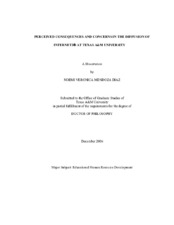| dc.description.abstract | The purpose of this inquiry was to examine the consequences and concerns with the diffusion of Internet2 at Texas A&M University (TAMU). Internet2 is a university-led effort to develop advanced network applications and the network technologies needed to support them. Internet2 adoption at TAMU took place towards the end of the 90s decade with the inclusion of the university in the University Corporation for the Advanced Internet Development (UCAID). This dissertation reviewed the Internet development and its relationship to universities. There were two theoretical models of change used, Diffusion of Innovations and Concerns-Based Adoption Model (CBAM). Specifically, “the consequences of change” was the focus in the Diffusion model, and “the stages of concern” was the focus in CBAM. This study used qualitative methods of inquiry with three sources of information --interviews, observations and archival information (printed and online). Seventeen participants were interviewed during the spring of 2006, selected on the basis of convenience, homogeneous, and snowball sampling. The participants were placed in an area, or an intersection of areas, of a diagram with teaching, research, and support-services realms. Through qualitative analytic induction, emerged twenty categories arranged in five different themes: (1) Texas A&M’s use of Internet2, (2) the dilemma of the information sharing, (3) the influences of Internet2, (4) Internet2 discussion, (5) Internet2 concerns. Internet2’s creation and Texas A&M University’s adoption rationale emerged through the narrative analysis. This study matched partially the frameworks of Rogers and Hall and Hord because a pre-stage of unawareness was necessary to install since Internet2 resulted to be extensively used at Texas A&M University, but with most of the users not aware of it. The audit trail, peer-debriefing, and member checks were the mechanisms installed to guarantee trustworthiness. Qualitative analytic induction and narrative analysis were the research strategies and the report was presented in the manner of a case study and summary of findings. | en |


